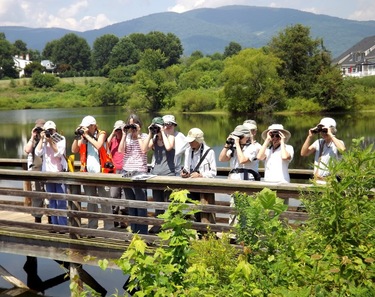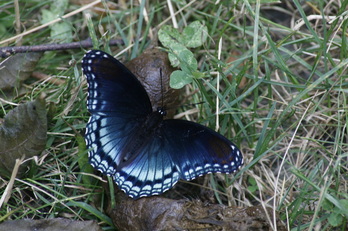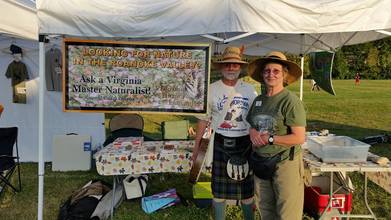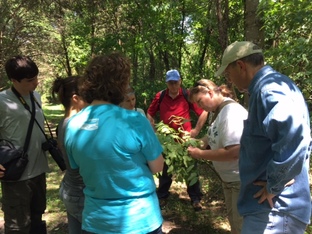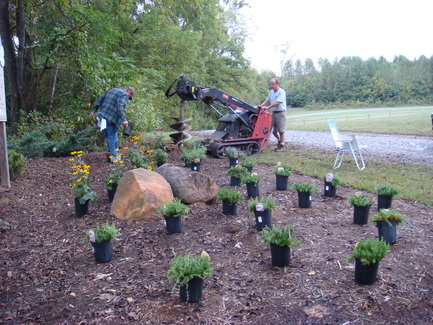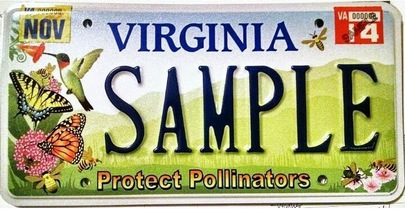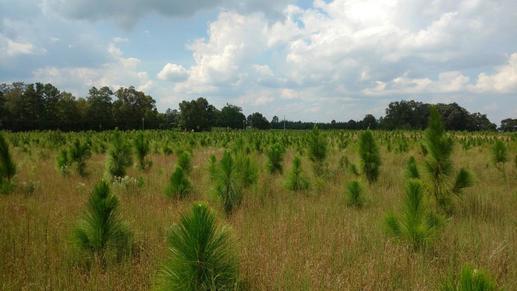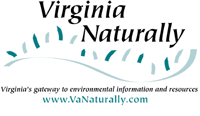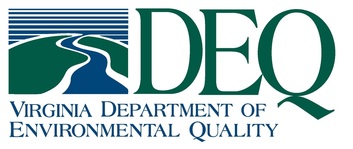Superlative Virginia Master Naturalists
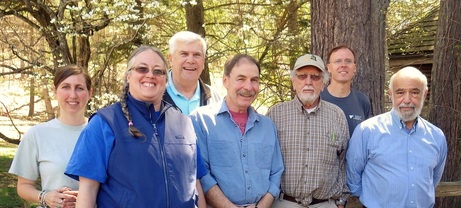 A few of the very dedicated volunteers of the Alleghany Highlands Chapter!
A few of the very dedicated volunteers of the Alleghany Highlands Chapter!
Most Volunteer Hours Per Active Member: Alleghany Highlands Chapter
This award is based on chapter annual reports for 2015 and data from the Volunteer Management System where VMN volunteers report their hours. We looked at the total number of 2015 volunteer hours submitted by each chapter, divided by the number of volunteers who submitted hours. We scale the calculation because our chapters vary so much in size. The chapter winning the award was quite small, just 12 active members. But, every one of those 12 volunteers completed way more than their 40 hours for certification. Most did double or even triple that. Some of the projects they did included monitoring raptors for Hawk Watch, monitoring water quality in local streams, and providing interpretive programs at Douthat State Park. We are thrilled to recognize the VMN-Alleghany Highlands Chapter for their accomplishment.
This award is also based on data from the Volunteer Management System. It recognizes the volunteer who completes and submits the most volunteer service hours in 2015. This year’s awardee is John Ford of the VMN – New River Valley Chapter. completed and reported 995 hours of Virginia Master Naturalist volunteer time in 2015. That is nearly the hours of a half-time job! In 2015, this volunteer helped remove invasive plants from Stadium Woods and the Huckleberry Trail in Blacksburg. He also served as continuing education and volunteer projects chair for his chapter. But, where he really spent his time was volunteering in the Virginia Tech Herbarium. In fact, he has come in to the Massey Herbarium three mornings a week for the last five years. During the last year, he has been playing a huge role in getting thousands of records added to the specimen database. His colleague at the herbarium wrote, “John’s help is tremendously appreciated. The Massey Herbarium has 109,000 accessioned specimens, and it is a daunting task to complete the database. We’re at 27%, but we’d be considerably lower than that without John’s untiring dedication to the effort. My hat is off to him!”
 Christine Hodges, Chapter Advisor of the Year (VMN-Alleghany Highlands Chapter)
Christine Hodges, Chapter Advisor of the Year (VMN-Alleghany Highlands Chapter)
Each of our VMN chapters has a Chapter Advisor who works with one of the seven state agency sponsors of the program. Our 2016 Chapter Advisor of the Year, Christine Hodges of the Alleghany Highlands Chapter, is described by the nominator as “a very superior advisor. She has all the needed skills and knowledge to do a fine job, but these are not her chief assets. It is her caring and kindness toward her students that makes her an excellent leader. She seems to anticipate special needs, and fulfills them without us asking. She is supportive and considerate of others, facilitating their goals.” Christine has been instrumental this year in putting on a successful new training course for her chapter which serves one of the most rural areas of the state. She is a 4-H Agent for Virginia Cooperative Extension in Alleghany County and Covington City.
For the Volunteer of the Year, we received 19 nominations of volunteers from 13 different chapters. Every single one of these people, as well as many who weren’t nominated, is truly a Volunteer of the Year. It is amazing what these individuals give to improving natural resource education, stewardship, and citizen science in their communities. We want to recognize all of the nominees, along with this year’s winner.
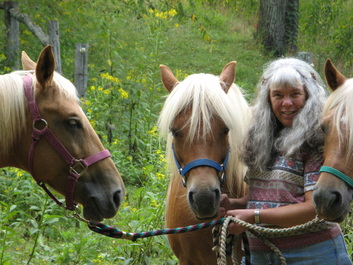 Susan McSwain (VMN Volunteer of the Year), and her ponies.
Susan McSwain (VMN Volunteer of the Year), and her ponies.
d his paragraph aloud. Much to her surprise, the opening sentence from this trainee began, “Susan McSwain is my favorite American Naturalist.” Congratulations, Susan McSwain, our VMN Volunteer of the Year! And, congratulations to all of our Volunteer of the Year nominees, listed here.
|
Name
|
Chapter
|
Nomination Highlight
|
|
Paxton Allgyer
|
High Knob
|
“Paxton is almost always in attendance
at chapter meetings, continuing education hikes and other activities and is always taking copious notes! It’s my belief that Paxton will prove to be a backbone of the High Knob Chapter in coming years.” |
|
Marian Childress
|
Tidewater
|
While most of us are sleeping, in the spring through the fall, she wakes daily at 3:30 am and mounts an ATV to survey miles of the beaches to identify a sea turtle nesting crawl or other marine animals that may have washed ashore. Marian spends countless hours alone protecting our
environment, not because she was told too, not because she is paid too, because she has the will to look beyond herself and see the greater good of her time spent as a VA Master Naturalist. |
|
Shirley Devan
|
Historic Rivers
|
Amazingly, she has recorded over 4000 volunteer hours, with over 100 hours just in the recent month of May. She inspires and motivates by her tireless efforts, the ripples of her pebble having spread far, both within and beyond our chapter.
|
|
Barbara Dunbar
|
Historic Rivers
|
When ideas and projects are discussed, Ms. Dunbar’s first words are always, “How can I help?” or “When do you need me?” Ms. Dunbar is the proverbial Energizer Bunny, helping out at all schools where needed, convincing new schools that they need school yard habitats and engaging partners to help them.
|
|
Kathy Fell
|
S0uthwestern Piedmont
|
The VMN Southwestern Piedmont Chapter has flourished under Kathy Fell’s leadership over the past two years. Her infectious wonder of the natural world, her superlative organizational skills, her ability to inspire, her high standards of science, her friendliness and hospitality, and her amazing energy level are the reasons that I believe she deserves this recognition.
|
|
John Gilliam
|
High Knob
|
John has taught classes, led outreach efforts and served the chapter well as its president since the chapter received its charter. John is passionate about the natural world, and the High Knob Chapter would not be where it is today without his work.
|
|
Laura Greenleaf
|
Riverine
|
Laura brought together a small group of enthusiasts to propose a new, with coalition-based approach which evolved into the James River Park System Invasive Plant Task Force. Laura has acted as coordinator: recruiting members, organizing meetings, and managing communication. With Laura as leader, the Riverine chapter continues to fill a leadership role
in a stewardship and education project of growing impact and staying power. |
|
Sandy Greene
|
Headwaters
|
She has been an inspiring figure for me and several of my classmates, organizing projects and work days, and explaining the inter-workings of government agencies with whom we cooperate. She has trained us in stream monitoring, as youth educators getting kids in the stream, and as public educators manning booths at festivals and creating pollinator gardens to raise public awareness, to name a few activities.
|
|
Daina Paupe Henry
|
Peninsula
|
Ms. Henry understands the value and benefits of education for life-long learners. This made her a perfect fit to lead the Chapter Basic Training Committee for the last three cohorts. While leading the Basic Training Committee, Ms. Henry has also led two significant Chapter projects: Endview Plantation and Water Quality Monitoring.
|
|
Lee Hesler
|
Pocahontas
|
Over the last three seasons, Lee has managed the Vernal Pool Cooperative project’s membership, pool inventory, data collection and submission, and data archiving. His
organizational skills and attention to detail have been superlative. He has personallyinteracted with each of the volunteers with the project and has developed a naming schematic for the individual sites. |
|
Gordon Kellet
|
Riverine
|
Gordon represents the Virginia Master Naturalists with enthusiasm and professionalism. His dedication to the Virginia Master Naturalists and passion for conservation have allowed for continuing effectiveness of our Outreach Committee as we engage with the community at farmer’s markets, various festivals, and other educational events.
|
|
Charles Petty
|
Old Rag
|
Charles has volunteered for every Meaningful Watershed Educational Experience (MWEE) with the Culpeper Soil and Water Conservation District for at least the last 5 years – reaching over 700 students a year. I know when he runs the macroinvertebrate station the students are in great hands!
|
|
Dianna Bridges
|
New River Valley
|
Additionally, Diane’s enthusiasm brings a sense of community to the chapter. She attends a majority of the chapter events, promotes publicity, and keeps the chapter moving forward and constantly evolving. She is a consistent contributor, always reliable, and goes above and beyond normal volunteering.
|
|
Tom Teeples
|
Northern Neck
|
He has an innate curiosity for nature and often engages our members as he finds some unusual species and asks for assistance in hunting down a likely identification. Tom became instrumental in developing walking trails around his retirement community for the residents and visitors to enjoy and use as part of their health and wellness programs.
|
|
Adrie Voors
|
Headwaters
|
This year, Adrie has created a compost drop-off station at our local Harrisonburg Farmer’s Market. The project is a first-year success collecting over 3000 pounds of waste from 544 donors in the first 3 months. Though the Market Compost project may be Adrie’s favorite volunteer project, it is certainly not her only one! She just never seems to stop!
|
|
Barbara Walker
|
New River Valley
|
Barbara has worked tirelessly developing the Pollinator Gardens at Pandapas Pond in Jefferson National Forest. Despite initial frustration (deer eating everything) she has persevered. With the help of volunteers, the gardens have developed into an educational showplace visited by hundreds of people yearly.
|
|
Elisabeth Wilkins
|
Peninsula
|
Ms. Wilkins oversaw the growth of the Chapter through the processes of new project approvals, more Partner contacts (especially the Virginia Living Museum in Newport News), and the training of a new cohort group. Ms. Wilkins also led the e-Mammal and vernal pools monitoring projects for our chapter.
|
|
Bill Wilkinson
|
New River Valley
|
One of the main project Bill Wilkinson and the MWC were involved with, for the second half of 2015, was trail building and making the steps at the Roanoke River Overlook, which had the ribbon cutting ceremony in February 2016. More than 2/3s of Bill’s volunteer hours have been trail building and maintaining – the real heavy lifting!
|
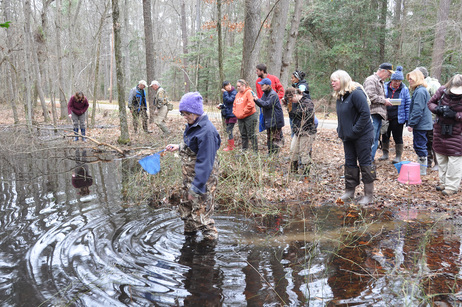 Training for Vernal Pools Cooperative project. Photo by VMN-Peninsula Chapter.
Training for Vernal Pools Cooperative project. Photo by VMN-Peninsula Chapter.
We aim with this award to recognize a project that has been created and led by a VMN volunteer or chapter and that has made significant and noteworthy positive impacts for natural resource education, citizen science, and/or stewardship within the last 1 to 2 years. We received some terrific nominations, and all of the projects are really noteworthy. The winning project is one that was an outgrowth of a collaboration among Virginia Commonwealth University and our program focused on the greater Richmond metro area, and it has since evolved to include 100 volunteers from at least 10 different VMN chapters and a new collaborator, the Department of Game and Inland Fisheries. The Vernal Pool Cooperative has volunteers finding, identifying, and monitoring vernal pool habitats in many areas of the state. Thus far, volunteers have identified 335 vernal pools in Virginia, and their data will help fuel conservation efforts for these special habitats. As I mentioned, many chapters are involved: Rivanna, Historic Southside, Peninsula, Shenandoah, New River Valley, and others, but since we had to choose where to give the award, we are giving it to the Pocahontas Chapter because that’s the chapter of a lead volunteer for the project, Lee Hesler. From the beginning, Lee stepped up to assume the management of the project’s online database, and has since managed the projects’ membership, pool inventory, data collection and submission, and data archiving. He has participated on the project’s steering committee and has helped to streamline the VPCV monitoring protocols. Lee has selflessly given up many of his Saturdays to help train over 300 volunteers in the data collection and entry process during 15 advanced training classes held around the state with participants from 11 MN chapters. In addition, he has continued to monitor and enter data on his own vernal pools sites in Chesterfield Co. Lastly, Lee has recruited and trained another Master Naturalist to take over for him, as he gets ready to retire from these past three years of oversight and effort.
Superlative Virginia Master Naturalists Read Post »

